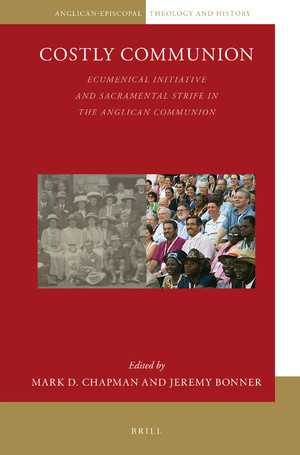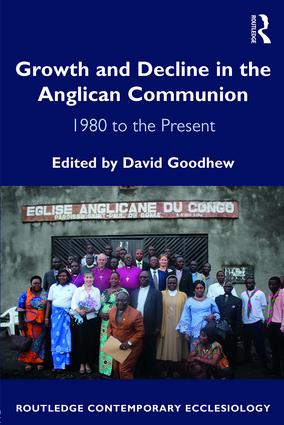The End of a Chapter
Yesterday, 220 years after its constitutional documents were adopted, The Episcopal Church (TEC) at its triennial assembly (the General Convention) in Anaheim arguably brought to an end its ambiguous double-life as both Anglican and Episcopalian. To put it another way, it finally conceded the logic of American denominational identity, which most of its mainline Protestant neighbors have long accepted, that it is a national church, bound by historical bonds of affection to other churches in the Anglican tradition but in no way obligated to look beyond the concerns of its members in discerning the future direction of its mission and ministry.
There have been other more bitter conventions. One can think of the harsh words exchanged between Evangelicals and Anglo Catholics in the 1870s, the "change of name" controversy at the beginning of the twentieth century, the struggle over "fundamentalism" in the early 1920s, the fractious debates over civil rights in the 1960s and female ordination in the 1970s. Sometimes there have been departures - the Reformed Episcopal Church in the 1870s or the Continuing Churches in the 1970s - but they were always on a small scale and did not ruffle relations with the Church of England. The year 2009, the culmination of events that began with Gene Robinson's election as Bishop of New Hampshire in 2003, looks set to be different. At both the global level and within the Church of England, there now stands the Fellowship of Confessing Anglicans, whose members subscribe to the Jerusalem Declaration issued by the Global Anglican Future Conference in 2008. Furthermore, a motion now looks likely to be presented at the Church of England's General Synod later this month to debate the future relationship of the Church of England to the newly formed Anglican Church in North America (ACNA).
Many observers will naturally argue, as indeed did Bishop Stacy Sauls, that the resolution in question (DO25) sought merely to reassert TEC's right to discern priestly vocation in its own cultural context and that it does not overturn a moratorium on the election on noncelibate homosexual clergy to the episcopate passed in 2006 (BO33). Those passionately demanding repeal of BO33 present at Anaheim, including The Reverend Susan Russell of All Saints, Pasadena, clearly do not see it that way.
There are plenty of well-informed sites now digesting the immediate consequences (as the links above testify) but the historical implications are equally fascinating. The whole pattern of schism (which is part and parcel of the American religious experience) has played out very differently in an Episcopal and Anglican context than anywhere else. Dual identity (one foot trapped in its English roots and one firmly planted on American soil) for years kept Episcopalians locked in a religious holding pattern that precluded formal separation (the fact that it was the only denomination to reunite almost immediately after the Civil War, where other Protestant groups endured as much as 100 years apart testifies to this). The institutionalist mentality - reflecting the state church status of its English parent - permitted a considerable diversity of opinion, while ensuring the election of bishops of generally conservative outlook but tolerant of clerical and lay dissent short of open defiance. Heresy trials were few, contentious issues generally shelved and congregational independence accepted de facto if not de jure.
The change that has come since the 1960s has followed both upon a change in the composition of the episcopal order and the decline of its standing as primus inter pares in church government. The prophetic mantle assumed by many bishops since Presiding Bishop John Hines - commendably - took it upon himself openly to challenge Southern segregation has undermined the corporate witness and collegiality of the House of Bishops. The upper house of General Convention seems increasingly to be viewed merely as a kind of religious Senate, which, despite the election of its members by the people of their dioceses, does not properly represent the popular will in the way that members of the House of Deputies do. It is interesting, given Bishop Robinson's expressed fears before the vote that he doubted the commitment of his colleagues to DO25, that it passed by much the same margin as his election in Minneapolis in 2003.
The other dimension is the global one. View them as interfering African schismatics or traditional Anglicans who cannot see a warrant for recent innovations, Global South leaders are now engaged with the process and closely associated with the new congregations of ACNA. Even at the height of its missionary activity (mostly in the Philippines and China), TEC never had the sense of identification with other Anglicans that many members of ACNA now do. Some of that is force of circumstance - especially for those communities who for a while relied on an African bishop for oversight - but it would be absurd to talk as if that was all there was to the relationship (it would be wrong, incidentally, to suggest that there are no deep transnational relationships, between members of TEC and Third World provinces, but in the current context they cannot be the same).
Schism Anglican Style. As (Arch)Bishop Duncan remarked to me a few years ago, there are many dissertations in the making. Let's hope there will soon be the seminaries to hire their authors.
Update: Statement of Kendall Harmon on Resolution D025
The passage of Resolution D025 by the General Convention of 2009 is a repudiation of Holy Scripture as the church has received and understood it ecumenically in the East and West. It is also a clear rejection of the mutual responsibility and interdependence to which we are called as Anglicans. That it is also a snub to the Archbishop of Canterbury this week while General Synod is occurring in York only adds insult to injury.
The Archbishop of Canterbury, the BBC, the New York Times and Integrity all see what is being done here. There are now some participants in the 76th General Convention who are trying to pretend that a yes to D025 is NOT a no to B033. Jesus’ statement about letting your yes be yes and your no be no is apt here. These types of attempted obfuscations are utterly unconvincing. The Bishop of Arizona rightly noted in his blog that D025 was "a defacto repudiation of" B033.
The presuppositions of Resolution D025 are revealing. For a whole series of recent General Conventions resolutions have been passed which are thought to be descriptive by some, but understood to be prescriptive by others. The 2007 Primates Communique spoke to this tendency when they stated “they deeply regret a lack of clarity”on the part of the 75th General Convention.
What is particularly noteworthy, however, is that Episcopal Church Resolutions and claimed stances said to be descriptive at one time are more and more interpreted to be prescriptive thereafter. Now, in Resolution D025, the descriptive and the prescriptive have merged. You could hear this clearly in the floor debates in the two Houses where speakers insisted “This is who we are!”
Those involved in pastoral care know that when a relationship is deeply frayed when one or other party insists “this is who I am” the outcome will be disastrous. The same will be the case with D025, both inside the Episcopal Church and the Anglican Communion.
D025 is the proud assertion of a church of self-authentication and radical autonomy.
It is a particularly ugly sight.
Source: http://www.kendallharmon.net/t19/index.php/t19/article/24426/









